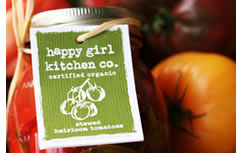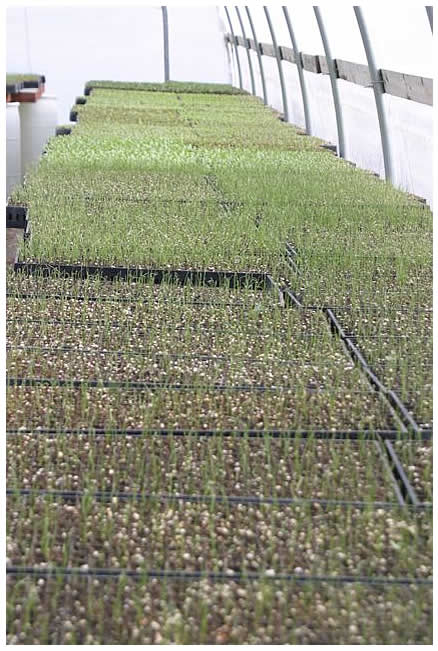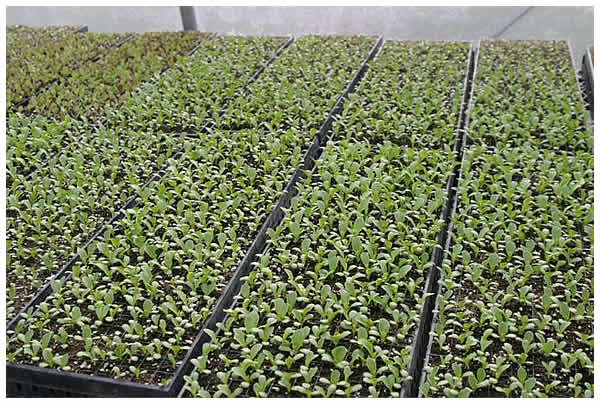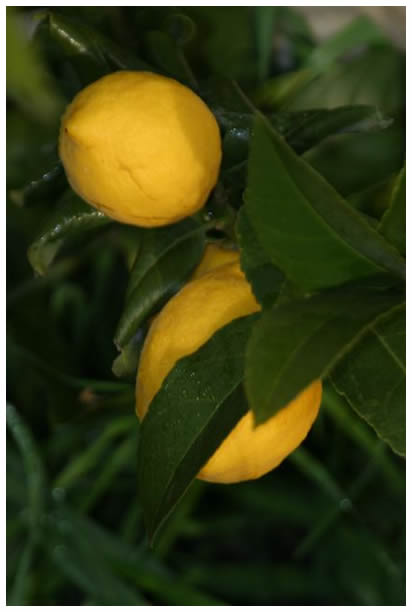
~~~~~~~~~~~~~~~~~~~~~~~~~~~~~~~~~~~~~~~~~~~
Live Earth Farm (Com)Post
5th Harvest Week, Winter 2007/2008
January 23rd, 2008
~~~~~~~~~~~~~~~~~~~~~~~~~~~~~~~~~~~~~~~~~~~
In this issue
--Greetings from Farmer Tom
--Happy Girl Kitchen Co.
--Teleconference with Joel Salatin
--Pictures around the farm
--What's in the box this week
--Notes from Debbie's Kitchen
--Contact Information
" We must not be afraid of dreaming the seemingly
impossible if we want the seemingly impossible to become reality. "
~ Vaclav Havel
Greetings from Farmer Tom
~~~~~~~~~~~~~~~~~~~~~~~~~~~~~~~~~~~~~~~~~~~~~~~~
 Sitting
in the comfort of a warm room on a cold wet day is the perfect environment
to dream about the crops I want to grow this year. I think of the farm as a blank
canvas and, for a brief moment, let my imagination run free and compose this
year's crop "painting". I am always inspired when leafing through
seed catalogs, reading up on newly selected varieties and comparing them to the "tried
and true" ones we have been growing every year. Like a painter would
study his colors, I have this large palette of crops to choose from to inspire
this season’s composition.
Sitting
in the comfort of a warm room on a cold wet day is the perfect environment
to dream about the crops I want to grow this year. I think of the farm as a blank
canvas and, for a brief moment, let my imagination run free and compose this
year's crop "painting". I am always inspired when leafing through
seed catalogs, reading up on newly selected varieties and comparing them to the "tried
and true" ones we have been growing every year. Like a painter would
study his colors, I have this large palette of crops to choose from to inspire
this season’s composition.Over the course of one growing season we grow more than 40 different kinds of vegetable crops, and typically several varieties of each. Selecting the right varieties takes time, and is one of the most important and exciting aspects of farming. Typically it takes a few years before a variety shows its full growing potential under the specific conditions we have on the farm. Each farm has a unique set of microcosms, and each crop will perform differently under the many factors that can influence its well being. My objective is to grow crops in as harmonious a way with nature as possible. Soil quality, sunlight, wind, humidity, temperature, pest and diseases, planting and cultivation practices, and other cultural and economic factors ALL play a role in deciding on a particular crop variety. In addition to all our regular crops, this season I would like to grow more flowers and herbs, and add some varieties of vegetables I have not tried to grow on a larger scale, such as pickling cucumbers, kabocha squash, popcorn, and watermelons. Debbie and Juan have been conspiring to convince me to grow sweet potatoes, something I have never tried before, since typically they need a warmer climate to perform well. In response to Debbie's urging we will also grow more peas, radicchio, and fennel. The most unusual crop we will trial this year is chayote, a vegetable trellised like kiwis and popular in Mexico and most tropical Latin American countries.
The green house is coming to life; the first seedlings are emerging from their tiny cells, and I am feeling a stirring of an all too familiar feeling . . . the first flicker of the Spring fire, tickling this sleepy farmer out of his short winter’s sleep.
- Tom
<back to top>
Happy Girl Kitchen Co.
~~~~~~~~~~~~~~~~~~~~~~~~~~~~~~~~~~~~~~~~~~~~~~~~
 Last
summer, when the farm was overflowing with ripe tomatoes and fresh basil,
Tom was prescient enough to contact Todd Champagne over at Happy Girl Kitchen
Company. Happy Girl is a local mom-n-pop operation that preserves the bounty
from local farms (like us!) in the form of pickles, sauces and the like, and
sells at farmers markets, online, and in a few stores in the Bay Area. I call
it prescient, because back then he thought to make arrangements with them to
preserve some of our summer bounty so that we could enjoy it now, as a part of
our winter share!
Last
summer, when the farm was overflowing with ripe tomatoes and fresh basil,
Tom was prescient enough to contact Todd Champagne over at Happy Girl Kitchen
Company. Happy Girl is a local mom-n-pop operation that preserves the bounty
from local farms (like us!) in the form of pickles, sauces and the like, and
sells at farmers markets, online, and in a few stores in the Bay Area. I call
it prescient, because back then he thought to make arrangements with them to
preserve some of our summer bounty so that we could enjoy it now, as a part of
our winter share!
Thank you Tom!!
For more information about them, visit their website:
happygirlkitchen.com
<back to top>
Teleconference with Joel Salatin
~~~~~~~~~~~~~~~~~~~~~~~~~~~~~~~~~~~~~~~~~~~~~~~~
Recently I have been engaged with the Farm to Consumer Legal Defense Fund [FTCLDF]
in their fight to preserve our access to raw dairy products, and so naturally
I am on their elist and receive information from them from time to time. This
latest item to cross my path caught my attention, and I thought our CSA members
might be interested.
The Farm-to-Consumer Foundation (a part of FTCLDF) 'organizes educational seminars
as vehicles for learning what we can all do to help' build a future of sustainable
farming and direct farm-to-consumer connections. This is their very first seminar,
and it will be in the form of a teleconference with none other than Joel Salatin
of Polyface Farm, in Virginia. Those of you who’ve read “The Omnivore’s
Dilemma” by Michael Pollan will know exactly who I’m talking about.
He's someone (I think) more of us need to learn something from. Here’s
the scoop. – Debbie.
The seminar is entitled “Bringing Farmers to the Plate – the Challenge
of rebuilding the local food web through farmer cooperation and consumer awareness” and
here’s what they have to say about it:
“Mr. Salatin will discuss the importance of creating local food networks
- how farmers can organize with other farmers, and how the consumer can play
a role to advance local sustainable farming.
“We visualize farmers and consumers stepping up to the plate equally to
ensure a world where small, sustainable farms can thrive and where, as consumers,
we continue to have excellent food choices. Indeed, at this critical juncture
in the history of farming and food, we must all make it a priority to do everything
we can to support our alternative food sources.”
The Teleconference is Weds. January 30th, 8pm EST (that’s 5pm here), and
there is a small ($20) fee to participate.
For more information or to register
for this event, please visit the Farm-to-Consumer
Foundation.
<back to top>
Pictures around the farm
~~~~~~~~~~~~~~~~~~~~~~~~~~~~~~~~~~~~~~~~~~~~~~~~

Our future vegetables...!

More seedlings. If you look very closely, you'll see that each seedling is
in its own tiny 'cell' in the seed starter flats. Think about the work
involved in seeing that one seed gets inserted into each little cell...
there's a LOT of work that goes on in the greenhouse year-round! Lettuce
alone gets seeded almost every week. Think about it.

Some of the farm's Meyer lemons are getting ripe... the trees are still small,
but one day soon we'll have them in our shares. Maybe not this season,
as the trees are still establishing themselves, but hopefully in the not-to-distant
future!
<back to top>
What's in the box this week
~~~~~~~~~~~~~~~~~~~~~~~~~~~~~~~~~~~~~~~~~~~~~~~~
Fuji apples (from Bobby Silva)
White beets
Brussels sprouts
Red cabbage
Green cabbage
Carrots
White onions (from Pinnacle Farms)
Romanesco cauliflower
Chard
Kale – Red Russian
Kale – Lacinato (Dinosaur)
Rutabagas
a jar of LEF dry-farmed tomatoes, canned by Happy Girl Kitchen Co! (see story)
Bread (this week for the Santa Clara County pickup locations: Los Gatos, Willow
Glen, Santa Clara and Sunnyvale)
<back to top>
Notes from Debbie's Kitchen
~~~~~~~~~~~~~~~~~~~~~~~~~~~~~~~~~~~~~~~~~~~~~~~~
Click
here to go to recipe database
I’m so excited about getting the preserved
tomatoes and basil – the
tomatoes are our dry-farmed tomatoes, which as you know are exceptionally sweet
and flavorful. I can’t wait to try them! We’ll have another go-round
of these tomatoes in the winter share next month, so please email me if you came
up with any particularly fun and wonderful ways to use them and I’ll share
your recipes in the corresponding newsletter! Meanwhile, it’s cold and
dreary out, so here are a couple of warming ideas for using what’s in the
box.
Oh, and FYI, I won't be able to upload this week's newsletter to the website
until next Sunday, as I'll be at the Eco-Farm conference (hooray!) later this
week, and I can't upload it until after I send it to our non-winter-share members
(which I do on Thursdays). But I'll get to it. I know you all like to have the
recipes available in the database. – Debbie
Roasted Cauliflower with a Roquefort crust
from an un-dated SJ Mercury News clipping, attributed
to the cookbook “Cheese,
Glorious Cheese!” by Paula Lambert
serves 8 [our cauliflowers are on the small side, so you may want to scale down
the recipe accordingly]
1 head cauliflower
2 tbsp. olive oil
¼ tsp. salt
½ tsp. freshly ground black pepper
a 6-inch piece of baguette [or similar; for making fresh breadcrumbs]
¾ C (4 oz.) crumbled Roquefort
½ tsp. minced fresh tarragon [probably not avaliable mid-winter; I’d
substitute ¼ tsp. dry. Rub it gently between your fingers to release the
flavor.]
Preheat oven to 400 degrees.
Place cauliflower in a small baking pan. Drizzle all over with olive oil, sprinkle
with salt and pepper, then roast for about 30 minutes, until cauliflower begins
to brown.
Meanwhile, cut baguette into half-inch slices and cut slices into quarters. Transfer
bread to a food processor fitted with a steel blade and process to make finely
chopped, fresh bread crumbs. Combine bread crumbs, Roquefort and tarragon in
a small bowl, mixing with fork or your fingers until the texture is uniform.
When the cauliflower begins to brown, remove pan from oven and, using your hands,
pat the Roquefort-seasoned bread crumbs onto it to encase it [I’d add:
be careful you don’t burn yourself on the hot pan!]. Don’t worry
if some of the crumbles fall onto the pan – they will toast and be absolutely
delicious. return cauliflower to oven and continue roasting for 5 to 10 minutes
longer, until bread crumbs on cauliflower have browned.
Remove from oven and transfer to a serving dish. To serve, use a sharp chef’s
knife and slice cauliflower into wedges, as if cutting a cake. Sprinkle any bread
crumbs that slide or fall off over the cauliflower. Serve warm or at room temperature.
Roasted Sausages, Apples, and Cabbage with Caraway
from an undated Bon Appetit clipping
Serves 2
3 tbsp. olive oil
1 tbsp. chopped fresh thyme
½ tsp. caraway seeds
4 1-inch-thick wedges red onion [sure, go ahead and use the white ones!]
2 1-inch thick wedges of red cabbage
2 small apples, quartered and cored
1 ½ tsp. balsamic vinegar, divided
3 assorted fully cooked smoked sausages
Preheat oven to 450 degrees. Mix oil, thyme and caraway seeds in a small bowl.
Arrange onion, cabbage and apples on a heavy large baking sheet and drizzle oil
mixture over. [Sometimes I like to toss everything in a bowl first, then spread
out on the baking sheet. It coats more evenly that way.] Sprinkle generously
with salt and pepper. Drizzle ¾ tsp. vinegar over cabbage and onion. [What,
not on the apples?] Roast 10 minutes. Add sausages to baking sheet and cook until
sausages brown and cabbage is crisp-tender, turning once, about 15 minutes longer.
Cut sausages diagonally in half. Transfer sausages, onion, cabbage and apples
to platter. Drizzle remaining vinegar over cabbage and onions and serve. [They
must have some reason for singling out only the cabbage and onions for the vinegar.
I wouldn’t be all that worried if you got vinegar on the other stuff too!]
Swiss Chard and Polenta Squares (Erbadela)
another Bon Appetit clipping. “Erbadela,
a specialty of northern Tuscany, is a good side dish for roasted meats, sausages
or fish, or an excellent meatless main course.”
Serves 4 as a main course or 6-8 as a side
1 C ricotta cheese
1 C whole milk
1 ¼ C grated Parmesan cheese (about 4 oz.)
1 C polenta or yellow cornmeal
1 tsp. salt
¾ tsp. ground black pepper
4 tbsp. olive oil
1 lb. green onions, coarsely chopped (about 6 cups) [! hm, that’s a lot
of green onions... I might substitute some chopped regular onion and minced fresh
parsley here, but that’s just me]
1 tsp. fennel seeds, slightly crushed
1 bunch Swiss chard, thick stems removed, leaves torn coarsely
Preheat oven to 375 degrees. Oil a 13x9x2-inch glass baking dish. Whisk ricotta
and milk in a large bowl to blend. Mix in Parmesan, polenta, salt and pepper.
Heat 3 tbsp. oil in a large pot over medium-high heat. Add onions and fennel
seeds. Cover and cook until onions soften, about 5 minutes. Add chard, cover
and cook until wilted, about 1 minute.
Stir chard mixture into polenta. Transfer to prepared dish. Brush 1 tbsp. oil
over top. Bake until brown around edges and firm in center, about 35 minutes.
cut into squares and serve.
Carrot Soup with Star Anise
modified from another Bon Appetit clipping...
they suggested using ‘pre-peeled
baby carrots’ – what were they thinking??
6 to 8 servings
3 tbsp. butter
1 ½ C chopped onion
6 large fresh thyme sprigs [it’s a good thing everybody planted their herb
gardens this summer, right? Thyme is a perennial, so it grows nicely through
the winter]
5 whole star anise, divided
2 bay leaves
1 large clove garlic, chopped
2 lbs. carrots, peeled [or scrubbed well] and chopped
4 C chicken stock or broth
Melt butter in large pot over medium-high heat. Add onion, thyme, 3 of the star
anise, the bay leaves and the garlic. Sauté until onion softens, about
5 minutes. Add carrots and broth. Bring to boil. Cover, reduce heat to medium-low
and simmer until carrots are very tender, about 30 minutes.
Remove and discard thyme sprigs, star anise, and bay leaves. Working in small
batches, puree soup in a blender until very smooth; return to same pot. Season
with salt and pepper.
Finely grind remaining star anise in spice mill or coffee grinder. Ladle soup
into bowls and serve sprinkled with ground star anise.
Roasted Brussels Sprouts with Lemon and Bacon
more Bon Appetit
serves 4
1 ½ lbs. small brussel sprouts, trimmed and halved
1 ¼ C diced bacon (about 6 oz)
1 lemon, halved lengthwise, thinly sliced crosswise [I’d carefully pick
out the seeds]
Preheat oven to 400 degrees. Cook sprouts in a medium saucepan of boiling salted
water until crisp-tender, about 5 minutes. Drain. [I’d steam them instead
of boiling; just sprinkle on a little salt first.] Spread sprouts on rimmed baking
sheet in a single layer. Sprinkle with bacon, lemon slices, salt and pepper;
stir. Roast until sprouts are tender and beginning to brown, stirring every 10
minutes, about 30 minutes. Transfer to bowl and serve.
Savory-Sweet Rutabaga Pudding
from Farmer John’s Cookbook
Serves 6 to 8
“Somewhere between a fluffy ricotta dessert and mashed potatoes, this delectable
rutabaga pudding has all the qualities needed to become a standard in your culinary
repertoire. This dish will surprise you in many ways: in taste, in texture, in
ease of preparing, and in the compliments it will bring to your table. It pairs
exceptionally well with lamb.” – written by friend of the [Angelic
Organics] farm; recipe adapted from Nika Hazelton’s Way with Vegetables.
1 lg. rutabaga (about 2 lbs), peeled and cut into 2-inch dice. [our rutabagas
aren’t that big; you’ll have to use more than one]
1 ½ tsp. salt, divided
butter for greasing the baking dish
2 eggs plus 1 egg yolk, beaten
¼ C heavy cream
¼ C dried bread crumbs
1 tbsp. maple syrup
a pinch of freshly grated nutmeg
1/3 C raisins, plumped in hot water for 15 minutes and drained (optional)
freshly ground black pepper
2 tbsp. butter
Bring a large pot of water to boil. Add the rutabaga and 1 tsp. salt, partially
cover, and cook until rutabaga is very soft, 30 to 45 minutes. (You will need
to reserve ½ C of the cooking water.)
Preheat oven to 350 degrees. Coat a 2-qt. baking dish with butter.
Beat the eggs and yolk in a medium bowl. Stir in the cream, bread crumbs, maple
syrup and nutmeg.
Drain rutabaga, reserving ½ C of the cooking water. Mash the rutabaga
thoroughly with a potato masher or run it through a food mill. If the mixture
seems dry, add a little of the reserved rutabaga cooking water as you mash. Add
the egg mixture, raisins, remaining ½ tsp. salt, and a few grindings of
pepper; stir to combine.
Transfer the rutabaga pudding to the prepared baking dish. Smooth the top and
dot with butter.
Bake until lightly golden on top, about 45 minutes. Serve hot.
<back to top>
Contact Information
~~~~~~~~~~~~~~~~~~~~~~~~~~~
email Debbie at the farm (for any farm or CSA share-related business): farmers@cruzio.com
email Debbie at home (with newsletter input or recipes): deb@writerguy.com
farm phone: 831.763.2448
website: http://www.liveearthfarm.net
~~~~~~~~~~~~~~~~~~~~~~~~~~~